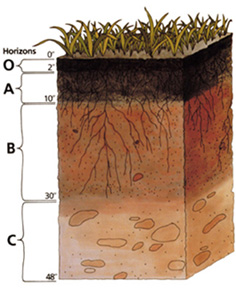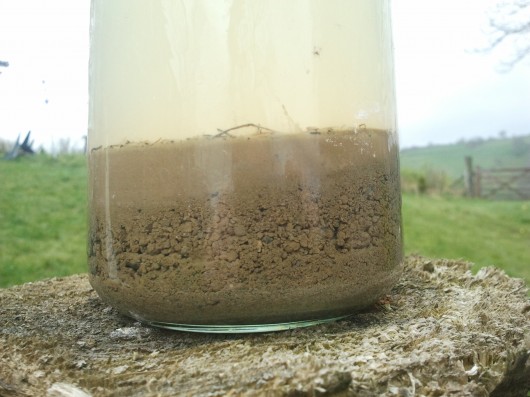2 – Soil testing
Testing soil for clay content
The aim here need not be a full scale scientific soil composition worked out, but to find out if you have earth that will be suitable for the application. Mainly, we need to see if there is enough clay in there. It isn’t quite as simple as aiming for a specific % of clay as there are many types, which have differing strengths and properties.
There are lots of tests and the more you handle different soils and play around with them in different forms, the more of an idea you will get for clay content and whether you have found some stuff worthy of taking forward to the next stage – plaster mix testing.
When soil testing be sure that you have dug below the organic and top soil layers (O and A) to the sub-soil (B). This will not smell ‘soily’, won’t be populated with loads of roots or worms and should look pretty different from the humus top layer.

Keep careful note of where the samples came from and the results etc. Try out several locations. Soil types can vary over very short distances, so if you have found some good stuff, it is worth checking that the area will provide enough for the project.
Good signs to look out for when digging:
- The spade creates a shiny surface.
- Cracked ground or water pooling can indicate a clay rich area.
- Observe how rocky the soil is – excessively rocky/ shaley areas will be harder to dig and you’ll have to do more digging and sifting to get the amount of earth you need- avoid if possible!.
There are lots of different tests you can do, these were our favourite ones:
The jar test
This is good for getting a feel for clay content and the amount of sand and gravel present. Take out any big stones and rocks, then fill the jar a quarter full with the sample soil. Top it up almost all the way with water, adding a teaspoon of salt gives clearer results but isn’t strictly necessary. Shake the jar thoroughly for a good 3 minutes then leave on a flat surface.
The sand will drop to the bottom within a minute or so, you can mark a line on the jar at that point. The water will still be murky with the suspended clay sediment. Leave it for 24 hours and then return – by then most of the clay should have dropped out and you can see how much clay is in the mix compared to sand. There is the ‘iffy’ aspect of silt with this test, which is difficult to spot – it is a layer between the sand and clay.

The sausage/worm and splat tests
These are fun to play around with and good to get a feel for how well earth will perform as a binder, or how sticky the clay is.
Wet the earth so it sticks together, but not so much you can squeeze water out if it. For the sausage/worm test, roll it into a sausage shape and see if it will stay together and you can hold it up by one end. If you can roll it into a worm 3 mm diameter or less and it still stay together, this indicates really high clay content.
The ‘splat’ or drop test is similar. This time make your wetted sample into a ball the size of your hand. Drop it from shoulder height onto a hard surface. If it stays together, likely there is a fair amount of clay in the soil. You can also try hurling the balls at a concrete block wall, if it sticks great! Low clay content balls would not survive that test either.
This is an excellent video of these two tests: http://www.youtube.com/watch?v=hh211b8b5FE
The ‘biscuit’ test
This one is good for testing the strength of the earth and seeing what kind of colour it dries to (not an instant result one though). Again start with wetted clay and mould it into a flattened ball about 1cm thick. Cut a disc/ biscuit shape for each sample (making them all the same size using a mould/ cutter will help with comparisons later). Wait for them to dry out completely (several days). If there is a fair amount of clay in the earth, it is likely the biscuits will have shrunk a little when dried and cracks will have appeared. You can then test for compressive strength by trying to crush the biscuit by pressing the centre between thumb and one finger. If the earth is very sandy or silty it isn’t likely to hold, if there is good clay content, it should feel pretty strong.

We found the combination of these tests meant we were confident there was enough clay in the earth to move on to the next stage…